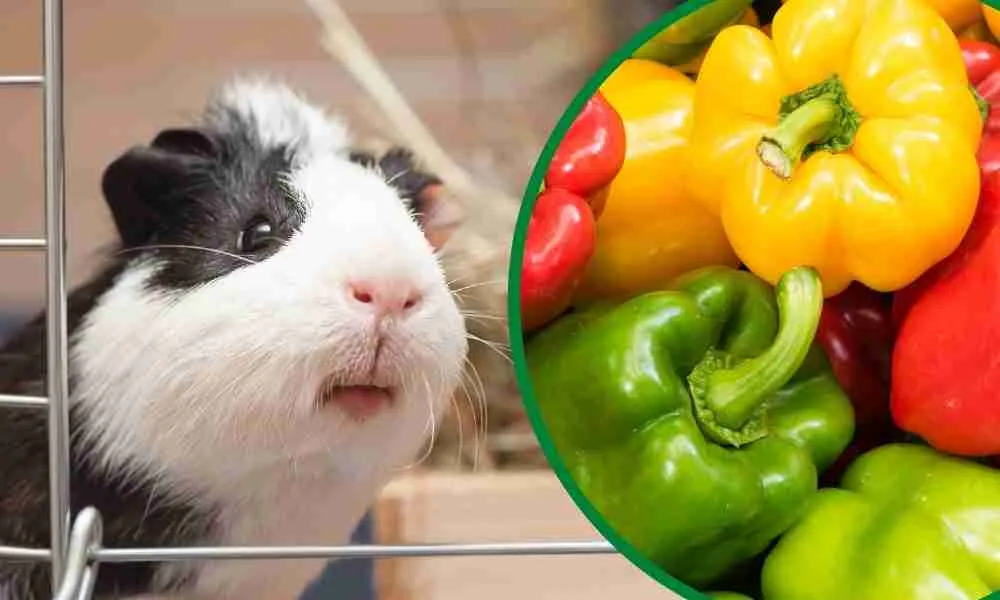Bell peppers are healthy veggies that taste great in salads. Aside from the flavor it gives, it has lots of nutrients in it and this looks healthy enough for your guinea pigs.
However, some foods that are good for us can be bad for guinea pigs, so to be sure about this veggie, you may wonder – can guinea pigs eat bell pepper?
Absolutely! Guinea pigs can eat bell peppers. They’re filled with useful minerals and vitamins like vitamin C, A, B6, and B9.
They are also known as sweet peppers because of their great taste, and crispy making guinea pigs generally love them.
Not only is it tasty for them, but it’s one of the best veggies treats to serve them. However, be sure to serve it to your guinea pig in moderation due to its sugar content.
Having known that your guinea pigs can eat bell peppers, you wouldn’t want to feed them a whole bell pepper, especially if you’re not sure how safe the parts are.
Moreover, this leaves you wondering – can guinea pigs eat a whole bell pepper?
Let’s dive deeper into this article to find out!
Table of Contents
Can Guinea Pigs Eat a Whole Bell Pepper?
No! Guinea pigs can’t eat a whole bell pepper. Just like most veggies, some parts of bell pepper are good for your cavy to eat while some can be toxic or bad for them to eat.
Let’s look at some common parts of bell pepper and also if your cavy can eat them.
Can Guinea Pigs Eat Bell Pepper Seed?
No, you shouldn’t let your guinea pigs eat bell peppers. Pepper seeds can likely make your furry friend choke just like most other seeds of different veggies and fruits.
These choking hazards are only what make this part toxic for guinea pigs. However, to be on the safe side and avoid any risk, don’t feed your cavy the seeds.
Can Guinea Pigs Eat Bell Pepper Skin?
Yes, guinea pigs can eat bell pepper skin. It has vitamin C, vitamin K, B vitamins, potassium, and many antioxidants that help keep the body in good condition.
Also, the skin is the part with the most fiber and that’s a major nutrient your cavy needs.
So, when preparing bell peppers, slice them with the skin.
And as it’s the outer covering of bell peppers, wash well before feeding them to your guinea pigs.
Can Guinea Pigs Eat Bell Pepper Leaves?
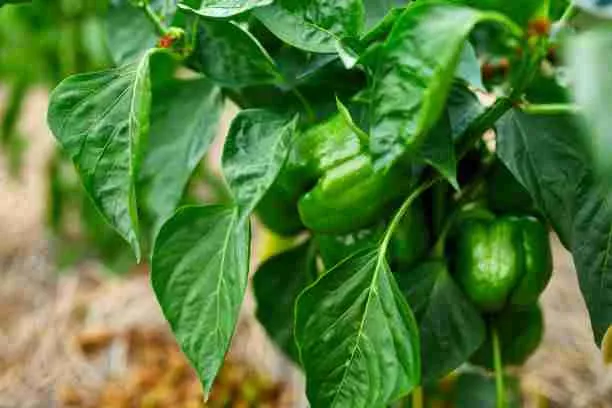
Not at all! Bell pepper leaves aren’t okay for your guinea pig to eat. These leaves are among the green parts. However, humans eat cooked bell pepper leaves and it’s safe for them to eat this way.
However, guinea pigs can’t digest any cooked food at all. So, whether it’s the raw ones or cooked leaves, don’t feed them to your guinea pigs.
Can Guinea Pigs Eat Bell Pepper Stem?
Not at all! Feeding your guinea pig’s bell pepper stem is a bad idea. Just like the leaves, the stem or stalk is among the green parts of bell peppers that your cavy can’t eat.
They contain alkaloids that are poisonous to guinea pigs. Also, they are tough to chew and digest and this will cause certain health issues if your cavy swallows them.
Can Guinea Pigs Eat Bell Pepper Daily?
It depends. Guinea pigs can eat green bell pepper daily. This is because they have a little amount of sugar in them.
However, other sweeter kinds like red, yellow, and orange bell peppers, are only safe for them to eat only 2-3 times a week due to their high sugar content.
Moreover, in a week, you should skip a day between the serving days of these sweet bell peppers. It shouldn’t be a straight two or three days. Give some gaps in between them!
Nevertheless, let’s look at the nutritional value of bell peppers, especially red (fully ripe) and green ones (unripe), per 100 g serving in the table below.
Nutritional Value of Bell Pepper
| Nutrients | Red Bell Peppers (Per 100 g) | Green Bell Peppers (Per 100 g) |
| Fiber | 2.1 g | 1.7g |
| Calories | 31 Kcal | 20 Kcal |
| Carbs | 6.03 g | 4.64 g |
| Sugar | 4.2 g | 2.4 g |
| Vitamin C | 127.7 mg | 80.4 g |
| Vitamin A | 157 μg | 18 μg |
| Vitamin K | 4.9 μg | 7.4 μg |
| Calcium | 7 mg | 10 mg |
| Potassium | 211 mg | 175 mg |
| Magnesium | 12 mg | 10 mg |
| Iron | 0.43 mg | 0.34 mg |
| Vitamin E | 1.58 mg | 0.37 mg |
| Folate | 46 μg | 10 μg |
| Vitamin B-6 | 0.291 mg | 0.224 mg |
| Protein | 0.89 g | 0.86 g |
| Fats | 0.3 g | 0.17 g |
| Zinc | 0.25 mg | 0.13 mg |
Benefits of Feeding Guinea Pigs Bell Pepper
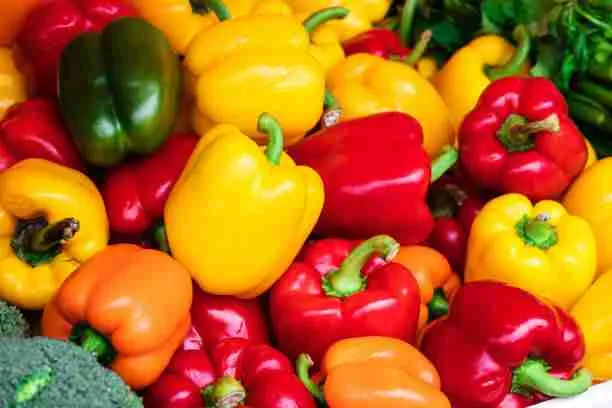
Improves Vision
Vitamin A is one of the useful vitamins you’ll find in bell peppers and it’s a well-known sight-booster. Serving your furry friend bell pepper would help boost their eyesight and keep it working in good condition.
You should also know that older cavies would benefit from this as they normally have problems seeing well.
Boosts Immunity
It’s good to know that bell peppers are also rich in vitamin C and many other antioxidants, including folate, that helps fight different kinds of diseases that happen in your cavy’s body.
Moreover, vitamin C is the main vitamin guinea pigs need to prevent scurvy, a common disease to guinea pigs.
Guinea pigs’ bodies fail to create vitamin C and when they lack it, they’ll suffer from scurvy. So, a vitamin C-enriched treat like bell peppers would keep your cavy immune to scurvy and other diseases.
Supports the Digestive System
Bell peppers have dietary fiber in them that can help to improve bowel movement and promotes digestion of other foods your guinea pigs eat.
Guinea pigs’ digestive systems are weak so this nutrient is a major nutrient a guinea pig needs but in normal amounts. Interestingly, the fiber in bell peppers is in normal amounts just the way your guinea pigs need them.
Helps in Hydration
Bell peppers are mostly made up of water. This water content is high, about 92%.
So, aside from the regular water that you give your little pet daily, this veggie can hydrate them well, especially during summer when it’s pretty hot.
Supports Healthy Bones and Teeth Development
Bell peppers are rich in calcium which can do so much for your little pet in small amounts.
Calcium helps in the development of the teeth and bone structures in your guinea pigs. A lack of this nutrient can make your guinea pigs weak and that’s not good for such a sensitive pet.
Aids relaxation
The B6 vitamin (folate) in bell peppers helps reduce stress and promotes good sleep for your guinea pigs. Moreover, one interesting thing folate does is to produce more happiness hormones in your cavy’s body.
How to Serve Bell Pepper to a Guinea Pig?
Preparing bell peppers properly is very important before serving them to your cavy. A wrong preparation can create serious risks to your guinea pig’s health.
Here are 5 simple steps you can follow to make sure you’re doing it right.
Step 1: Select Only Fresh Bell Peppers
When choosing fresh peppers to use, have in mind that guinea pigs are sensitive pets and their foods need to be carefully selected.
Nevertheless, you shouldn’t use leftover bell peppers or ones that are already spoiling to prepare this treat for them.
Instead, you should carefully pick fresh ones, especially when you buy them from the stores.
Step 2: Remove Green Parts of Bell Peppers
Before you wash bell peppers, get rid of the green parts that are harmful to your guinea pig. These parts are the tops, leaves, and stems.
Also, don’t forget to remove the seeds as this part, just like other seeds of different fruits and veggies, can make them choke.
Step 3: Wash Bell Peppers Thoroughly
Before you slice bell peppers, dip them in a bowl of warm water and wash them well.
This step is an important step to get rid of dirt, and chemicals, like pesticides or herbicides that are normally used to grow them.
Step 4: Slice Bell Peppers into Moderate Sizes
With a knife and a board, cut bell pepper into wide strips. This should be about half an inch in size. This is necessary to keep the sugar and other compounds like calcium that could harm them in excess, moderate.
Step 5: Serve Bell Peppers
When you’re done slicing the bell pepper, you should serve not more than two slices or strands to your cavy. Also, you should do it on a clean surface.
However, if it’s a new treat to them, start with little sizes that are even smaller than the ideal serving size.
Take Note!
- It’s ideal to use organic bell peppers, like ones in your garden that are free from chemicals. This is safer to use as the ones in stores normally have chemicals on them and washing it might not get rid of them all.
- Remove bell pepper leftovers from your guinea pig’s feeding area a few hours after serving them, especially when you’re sure your little pet is done eating. When these leftovers are exposed, bacteria grow on them and that’s not safe for your cavy to eat at all.
Risks in Feeding Guinea Pigs Bell Pepper
Allergy
You should know that most guinea pigs can react negatively to certain things they try new.
They can though is a rare thing for guinea pigs to build an allergy to bell peppers, but remember, cavies aren’t the same.
When you feed them bell peppers, they could have negative reactions, like diarrhea or vomiting, all because it’s something new to them. So, to avoid this risk, you should introduce bell peppers gradually to them.
Digestive Issues
Your guinea pigs can get sick when they get an overdose of most compounds in bell peppers. Moreover, this mostly happens during wrong preparation.
Bell peppers have so much sugar in them and guinea pigs just need them in very little amounts.
When you feed your cavy more than the proper serving size, the excess sugar they’ll get can cause serious digestive issues for them, like bloating, gas, and diarrhea.
Urinary infections
Guinea pigs, particularly older ones, need calcium only in small amounts. Too much of it can lead to kidney and bladder stones, which are very painful conditions and can lead to death.
Bell peppers have so much of it, so you should always keep it moderate, especially when preparing bell peppers, to avoid these health issues.
What Kind of Bell Peppers Can Guinea Pigs Eat?
Interestingly, bell peppers are of different kinds, and what differentiates them all is their colors. These colors are red, orange, yellow, green, purple, white, and brown.
However, these colors are just different stages of ripeness. Let’s look at some of these bell peppers and whether your guinea pig can eat them.
Can Guinea Pigs Eat Orange Bell Peppers?
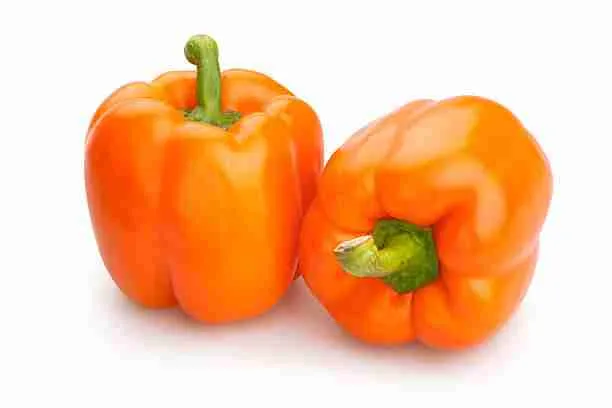
Of course, you can serve orange bell peppers to your guinea pig. This kind of bell pepper is rich in many nutrients, especially vitamin A, vitamin C, and potassium, that your cavy’s body needs.
However, because of the high sugar content and calcium in it, you should serve for just a few days, about 2 -3 times a week. Also, don’t forget to keep the serving sizes in bits.
Do Guinea Pigs Eat Yellow Bell Peppers?
Yes, they do! Yellow bell peppers are good for them to eat. These bell peppers have so much vitamin C in them, and also important minerals that will help keep your cavy’s body in good condition.
However, you need to feed them this kind of bell pepper moderately because it has so much calcium and sodium.
Yellow bell peppers have a small number of fats and calories in them so they’ll promote a healthy weight for your cavy.
Can Guinea Pigs Eat Purple Bell Peppers?
Yes, you can feed this kind of bell pepper to guinea pigs. Bell pepper with a purple color might seem to be a toxic one for cavies, but that’s not true at all.
Although they’re not common, they’re healthy for your cavy to eat. The vitamins in it, especially vitamin A and C, help keep your guinea pigs healthy.
However, only serve small amounts of it to your cavy and do it for just a few days a week
Can Guinea Pigs Eat Green Bell Peppers?
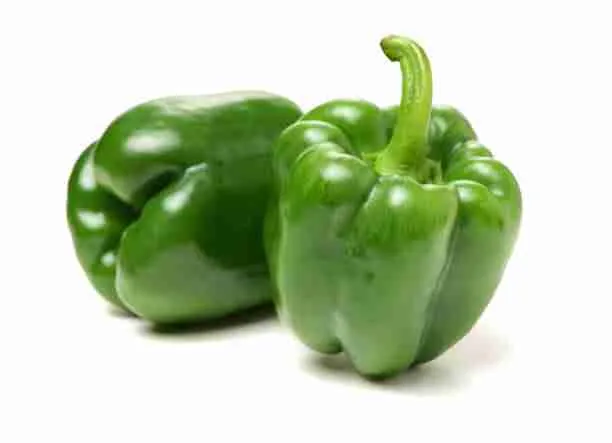
Absolutely! You can feed your guinea pigs green peppers. In fact, they are the safest kind of bell peppers your cavy can eat.
Among all the bell peppers, these kinds have the lowest sugar content.
Moreover, because they’re green doesn’t mean they’re unsafe to eat like the green tops, leaves, and stems of bell peppers in general. They’re green because they’re just unripe.
Despite this, they’re still filled with many useful vitamins and antioxidants that are important for your guinea pigs’ wellness.
Interestingly, they’re also low in fats so they can’t promote unhealthy weight gain.
Can Guinea Pigs Eat Mini Bell Peppers?
Absolutely! Guinea pigs can eat mini bell peppers. This bell pepper is a good one for your cavy. However, they aren’t special kinds of bell peppers at all.
They are only smaller kinds of bell peppers. The only thing different is that they taste sweeter. However, when serving them to your guinea pigs, they should be in moderate sizes.
Moreover, it shouldn’t be a daily treat too because of the high amount of sugar in it. The serving days should be about two times a week.
Can a 4 Week Old Guinea Pig Eat Bell Peppers?
Not at all! Guinea pigs are still babies for about 6 months. So, at 4 weeks of age, they’re still babies and are still very young to have bell peppers.
One thing you should look at is the sugar content, especially in the colorful types of bell pepper.
This is kept moderate for even adults, so a 4-week old baby guinea pig is at more risk. This is just the same case with most fruits and veggies that are high in sugar.
Bell Pepper Alternatives
Guinea pigs benefit the most when you mix things up in their diet.
Providing them with different kinds of healthy veggies every day creates a more rich diet and also, would help balance things, especially the nutrients they’ll get from them.
You wouldn’t want to stick to one veggie, and definitely not bell pepper. So, try swapping these veggies from time to time with other alternatives like these:
| Cabbage | Cilantro | Beet | Sweet Potato |
| Parsley | Mint | Carrot | Artichoke |
| Lettuce | Cucumber | Spinach | Basil |
| Pumpkin | Tomato | Watercress | Romaine |
| Corn | Celery | Zucchini | Kale |
| Brussel sprouts | Asparagus | Green beans | Broccoli |
Final Thoughts
In summary, guinea pigs can have bell peppers. The nutrients, especially vitamin C makes them an important treatment for your cavies’ well-being.
Just the same way guinea pigs can eat tomatoes and not the green parts, you should let them bell peppers without the tops, leaves, and stem.
In addition, you can follow the guide in this article to prepare bell pepper treats for your little pet to avoid certain risks. And if you like to add bell peppers to their treats daily, only stick with the green ones.
However, serve bell pepper moderately and only a few times a week, especially the sweeter ones.
Read more of our blogs to learn more about other healthy foods, especially veggies, which guinea pigs can eat.
Moreover, if you found this article helpful, do well to share it!
